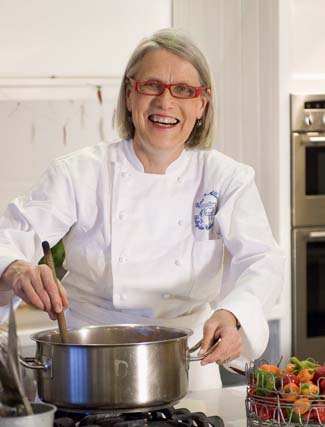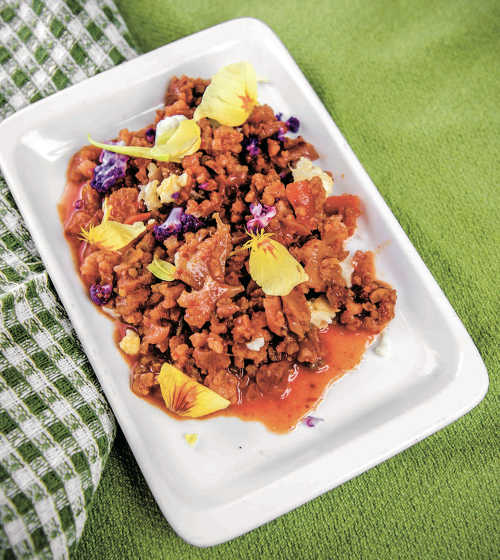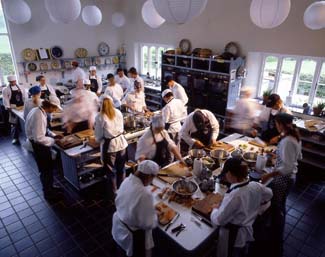The Darina Allen Column

IFEST, the first major celebration of Irish culture and food was held in Boston recently - and Darina was there
It’s the brainchild of Rachael Kelly, the young entrepreneur who was behind the Taste of Dublin festival for many years. Her vision is to take IFEST to all the American cities where there is a strong Irish diaspora and not just to celebrate Ireland but to generate both business investment and tourism.
Rachael invited me to cook the Welcome Gala Dinner at the Seaport Hotel on the opening night with Boston chef Lydia Shire, we had lots of fun in the kitchen with a terrific supporting cast.
Birgitta Hedin Curtin brought her Burren smoked wild Irish salmon all the way from Lisdoonvarna in Co Clare which we served with pickled red onions and Arjard, and lots of freshly baked Ballymaloe brown bread and white soda bread slathered with Kerrygold butter.
Next there was pea and cilantro (coriander) soup followed by lamb with eggplant (aubergine) and rocket. Lydia Shire’s son had cooked a beautiful plate of haddock and lobster in foaming Irish brown butter with cape gooseberries and sugar pumpkin soufflé.
My team at the Ballymaloe cookery school made hundreds of crackers to go with the Cashel Blue, Dubliner and Skellig cheeses and then came Lydia’s interpretation of Irish coffee meringue — a fluffy pavlova served with Jameson cream and a square of coffee jelly; a real ‘ta dah’ dessert that rounded off the meal in a delicious and memorable way.
The festival ran over three days with Jameson whiskey and Dingle gin well represented, as well as numerous other Irish companies. I gave a couple of demonstrations of Irish baking: barm brack, orange scones, spotted dog and Auntie Florence’s crumpets.
After each demonstration the audience surrounded the podium and devoured every morsel. Kevin Dundon from Dunbrody House and Cathal Armstrong, originally from Dublin, also gave cookery demonstrations as well as many well-known Boston chefs including Barbara Lynch, Ana Sortun and renowned Sofra pastry chef Maura Kilpatrick.
As usual I whizzed around town to check out the food scene. I loved the food at Sofra, a Middle Eastern bakery and café and picked up lots of goodies at unmissable Formaggio, a grocer and cheese shop.
I also had a delicious dinner at Barbara Lynch’s Sportello, most memorable was a dish of pasta with rabbit and green olives. Row 34, close to the Seaport, was also throbbing. I managed to take in two Farmers Markets: one at Union Square, the other at Eccleston Place, close to Jamacia Square where there was a Fermentation Festival in full swing. I bumped into Sandor Katz, the fermentation guru who has been one of the stars of the LitFest for the past two years.
I also loved a little shop called Farm and Fable owned by Abbey Ruettgers who I surprised when I walked in. Abbey had been to Ballymaloe for a week when she was 12, and I can’t imagine how she recognised me.
Finally on Sunday evening just before I dashed to the airport, I had a selection of small plates at Coppa, delicious food in a really cool neighbourhood restaurant, a must for your Boston list. Farm and Fable, Formaggio and Coppa are within a few steps of each other on Shawmut Avenue in Boston.
 Jamie Bissonnette’s Cauliflower Kimchi
Jamie Bissonnette’s Cauliflower Kimchi
Chef Jamie Bissonette won a James Beard Award and has recently published a new book on Charcuterie, to make and serve at home. If you want to learn about fermenting meats, I recommend learning how to make kimchi, or fermented vegetables, first. This is good training because it shows patience! You can substitute any number of vegetables in this traditional Korean recipe, including cabbage, swede turnip, carrots, radishes or cucumbers.
1 head cauliflower
2 tbsp (30g) ginger
6 cloves garlic, minced
1½oz (80g) coarse Chilean chilli flakes
3 red radishes, sliced
1 carrot, peeled and grated
3 sprigs scallion chopped rough
16 fl oz (450ml) fish sauce
2 oz (60g) palm sugar
Juice of 2 limes
1 cup (225ml/8 fl oz) water
Chop the head of cauliflower to resemble large pieces of couscous. Combine all ingredients and mix thoroughly. Add 1 cup (225ml) water, or enough water so that mixture is three quarters covered with water.
Put in an airtight container and let it sit in a cool, dry place for 1 week.
Check it every day and shake it up if any fuzz appears on the surface. After one week it’s ready to eat — and it will keep in the refrigerator for up to 30 days.
If you’re not patient enough to wait a week, double the lime juice and let the kimchi sit overnight in the refrigerator. It will be ready to eat immediately.
[From The New Charcuterie Cookbook by Jamie Bissonnette, published by Page Street Publishing.]
Jamie Bissonnette’s Green Tomato Chutney
Makes 4 pints (1.8l)
A lot of farmers come to us with green tomatoes, and you can only pickle or fry so many. I started making chutneys out of them, and this recipe is so popular we make it in 20-pound batches.
The sour, tart flavour of the green tomatoes combined with the sugar yields sweet and sour flavoured chutney that can be served on anything from cheese to Foie Gras Torchon.
4 cloves garlic
1 piece mace
1 broken piece cassia bark
1lb (450g) green tomatoes, roughly chopped
2 cups (480g) sugar
¼ cup (60g) yellow mustard seeds
1 tbsp (15ml) molasses
2 tbsp (30ml) white wine vinegar
1 tbsp (15ml) mustard seed oil
Sachet in cheesecloth:
4 garlic cloves,
1 piece mace
1 broken piece cassia bark
Mix the tomatoes with the sugar and let sit overnight in the refrigerator, or at least 12 hours.
Combine sugared tomatoes with all other ingredients in a pot. Cook over a medium heat for 45 minutes, adding ¼ cup (60ml) water if it’s too thick.
Alternatively, add 1 cup (240g) chopped Indian lime (right out of the jar) and use over steamed white rice.
[From The New Charcuterie Cookbook by Jamie Bissonnette, published by Page Street Publishing.]
Strozzapreti with Rabbit and Green Olives
We loved this dish from Barbara Lynch, which is considered to be a classic at Sportello, one of her restaurants on Boston.
16fl oz (450ml) strained stock
1 cup chopped green olives
3 sprigs fresh rosemary
1 whole rabbit, broken down (forearms, thighs, loins) and carcass reserved for stock
Fresh strozzapreti (recipe below)
Salt and pepper
Grated Parmesan cheese
Rabbit Stock:
2 tbsp extra-virgin olive oil
1 rabbit carcass, chopped
1 small onion, peeled and diced
2 ribs celery, diced
1 carrot, peeled and diced
2 cloves garlic, peeled and diced
8fl oz (225ml) white wine
Strozzapreti:
10 oz (275g) semolina flour, divided
Pinch of salt
8fl oz (225ml) warm water
Place strained stock in a sauce pot, bring to a simmer and reduce over medium-low heat for about 10 minutes. Add chopped olives, rosemary and rabbit meat and cook for another 20 minutes. Pierce meat with a fork — meat should pull away from the bone easily.
Remove meat, chop into smaller pieces and add back to sauce, continuing to reduce for 10 minutes. Toss with cooked strozzapreti and season with salt and pepper to taste and a bit of grated Parmesan to pull it all together.
Rabbit Stock: In a medium-size braiser, heat oil over medium heat. Add rabbit bones, and brown. Remove bones and set aside, then add forearms, thighs and loins and sauté until browned. Remove and set aside. Add onion, celery, carrot and garlic and sauté until softened and fragrant, about 7 minutes. Add wine, scraping up any browned bits, then add the bones and enough water to cover. Bring to a boil and cook for 1 hour. Reduce to a simmer and cook for an additional hour. Cool, strain, and reserve.
Strozzapreti: Place 7½ oz (210g) semolina with salt in a mixer with hook attachment (save the remaining 2½ oz (60g) for the sheet trays). Add water slowly, and mix until a nice smooth ball of dough is formed, about 7 minutes. Remove and rest under a damp cloth.
Divide the dough into thirds, and shape one portion at a time, keeping the remaining dough covered. On a wooden board, form large pea-size pieces of dough. Using you index and middle fingers, roll a piece toward you, back and forth a few times until about 2 inches (5cm) long and thicker in the middle. If the board is too dry, wet it with a damp cloth (You will know if you need damp cloth if the pasta isn’t rolling easily!).
After rolling, place shaped pasta on a sheet tray or flat plate sprinkled with semolina and freeze or refrigerate until you are ready to cook it.
'30 Years at Ballymaloe' - Bord Gáis Avonmore Cookbook of the Year 2013
Good Food Ireland Cookery School of the Year 2012/2013
Ballymaloe Literary Festival of Food and Wine 15- 17th May 2015
www.litfest.ie
***
 The Ballymaloe Cookery School in East Cork has a great programme of cookery courses for all interests and abilities running throughout 2014. Ranging from a relaxing visit to sit in on an afternoon cookery demonstration to a week long ‘Intensive Introductory Course’.
The Ballymaloe Cookery School in East Cork has a great programme of cookery courses for all interests and abilities running throughout 2014. Ranging from a relaxing visit to sit in on an afternoon cookery demonstration to a week long ‘Intensive Introductory Course’.
Sitting in the middle of a 100 acre organic farm the Ballymaloe Cookery School provides its students not only with a life skill learnt under the expert tutelage of their very capable teachers but also a place to relax and unwind from the stresses and strains of normal everyday life. The cottage accommodation available onsite for residential courses consists of a collection of delightful converted outbuildings which have been transformed over the years by the Allens, and other accommodation is available locally for the short courses.
www.cookingisfun.ie





There are currently no comments
Leave a comment
Not a member? Register for your free membership now!
Or leave a comment by logging in with: